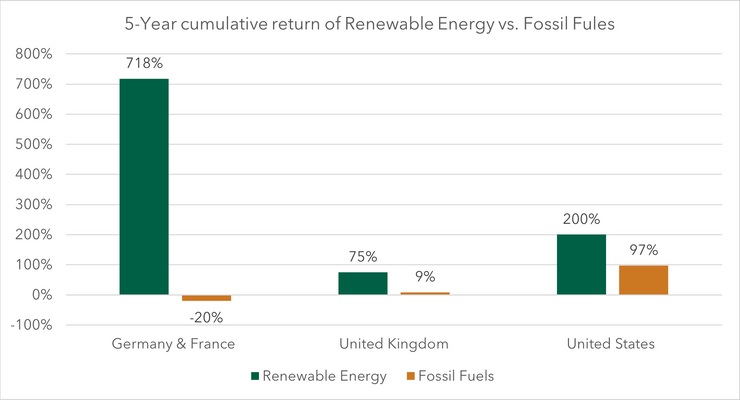Renewable Energy - The price you pay still matters

Pella Funds Management
Most of Australia’s energy needs have been largely met by fossil fuels. Australia’s abundant and low-cost coal resources are used to generate three-quarters of domestic electricity and underpin some of the cheapest electricity in the world. Our transport system is heavily dependent on oil, some of which is imported. At this point, renewable energy sources account for only modest proportions of our primary energy consumption (about 5 percent, US 18%).
Wind, hydropower, solar, biomass and geothermal renewable sources are a lot cheaper so why is well over half of our electricity still being generated using carbon-emitting fossil fuels?
The short answer is the grid is just not equipped to handle renewable energy. It needs to be used the moment it is generated. Currently it can be stored in small amounts but it’s not enough for it to be a sole resource. Renewable energy is not without its shortfalls. Despite the problems renewable energy presents, there is no question that we must increasingly transition away from fossil fuels towards wind, solar and hydropower.
The good news is, there are many potential solutions and many still being explored. We haven’t yet exhausted our options and we think there is plenty to benefit from when it comes to investing in this space.
Pella Funds Management focusses on beating the market, with lower volatility and with superior sustainability and ESG credentials than the market. The business is structurally built to achieve these targets. You can read more on our Sustainability processes on our website, pellafunds.com.
Here we highlight a key positive theme running through the veins of our portfolio.
In developed markets renewable energy investments deliver far better returns than fossil fuels, nevertheless the total volume of investment into the sector is still nowhere near that required to mitigate climate change. We think there is plenty of upside potential and if you are willing to be selective on which stocks to own and what to pay for them you stand to potentially generate significant returns.
A recent report published by Imperial College London and the International Energy Agency, assesses stock market data to determine the rate of return on energy investments over five years to 1Q20. The study took an equal weighted approach to a “Fossil Fuel” portfolio and a “Renewable Energy” portfolio. Fossil fuels included coal operations, exploration and production, integrated oils, midstream (oil and gas), oil and gas services and refining and marketing. The renewable portfolio was created by 4 subsectors, renewable energy equipment manufacturing, renewable energy project developers, green utilities and yieldcos (holding companies for operational renewable power projects).
The study found that the Renewable Energy portfolio did not only significantly outperform the Fossil Fuel portfolio but did so with lower volatility. On average the standard deviation was approximately 4% lower for Renewable Energy.

Source: Imperial College London and the International Energy Agency.
We know the potential is there, but to make a good investment you need to be very specific about the company you select, the price you pay and how it fits into the portfolio mix.
Pella’s philosophy dictates that price always matters. It can be the most sustainable business in the global market but if it doesn’t meet our strict stock selection criteria, we simply will not buy it.
It must meet our criteria:
The business must be sustainably growing – this is where we assess the durability of growth
It must exhibit favorable secular growth and
Stack up on our FCF yield measures relative to growth and risk metrics.
One of Pella’s stock picks within renewable energy is Sunrun. It’s one of the less obvious ways to invest in solar. Although the solar sector was severely affected by COVID-19, it experienced a rapid recovery with the Invesco Solar ETF rising near 450% (another huge number) from the lows in March 2020.
We think Sunrun has attractive valuation metrics. According to our thesis we believe that Sunrun’s adjusted forward free-cash-flow yield is at least 4%. Given Sunrun’s track record, significant long term growth potential and strength in the environmental criteria, we believe the current valuation represents good value. Sunrun can become a Core holding in the longer term as cash flows improve and we will look to engage with the company to improve its social and governance criteria.
What we can conclude about the sector is that Renewable Energy has outperformed Fossil Fuels and we expect will continue to outperform in the longer term. During periods of high market and oil price volatility, Fossil Fuel portfolios experienced larger drawdowns. These are crucial signals for investors to consider. The growth is there, if you spend time understanding the business fundamentals you can find ways to outperform, manage risk and invest in a way that yields better result for our planet.
(VIEW LINK) Bloomberg, Centre for Climate Finance and Investment
2 topics

Joy is the Head of Distribution of Pella Funds Management. She has built her career in funds management over the last 15 years. Prior to joining Pella, Joy was the Executive Director of Pengana’s International Equities division. Her experience...
Expertise

Joy is the Head of Distribution of Pella Funds Management. She has built her career in funds management over the last 15 years. Prior to joining Pella, Joy was the Executive Director of Pengana’s International Equities division. Her experience...
